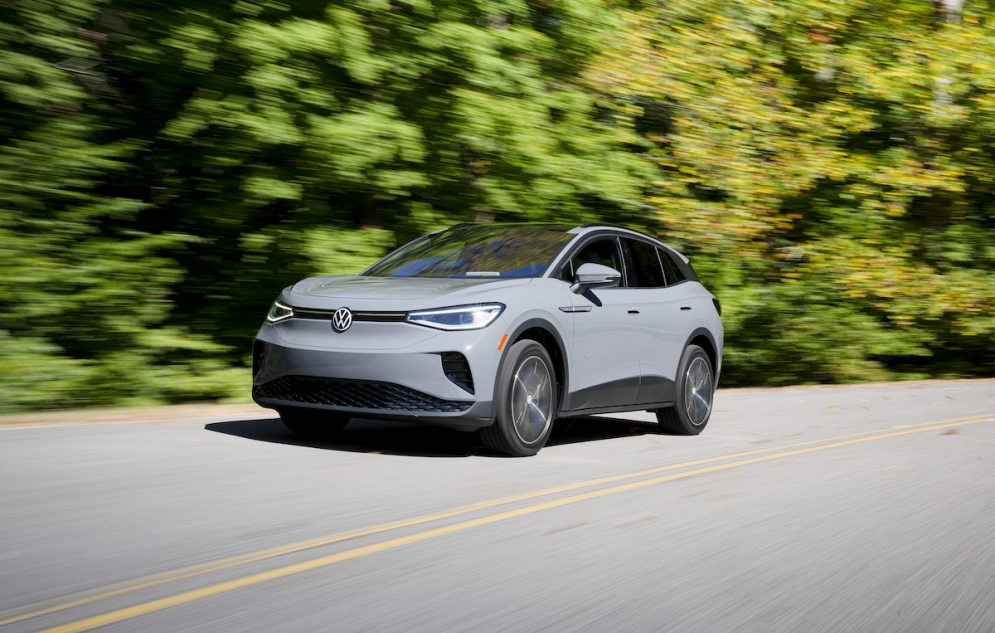LOOKS
The 2023 Volkswagen ID.4 features an attractive exterior design highlighted by an elegant and functional front grille, and sharp design of the LED headlights. And you wouldn't know it's an EV on first glance, which I suppose is a bit of a compliment.
It’s also well-designed to limit drag by controlling air flow.
19-inch wheels are standard, but you can upgrade to 20-inch alloy wheels. In terms of size, it’s just a bit smaller than Volkswagen’s Tiguan SUV.
Paint colors available include: Pure White, Silver Mist Metallic, Pure Grey, Deep Black Pearl, Tourmaline Blue Metallic, Opal White Pearl, Aurora Red Metallic, and Arctic Blue Metallic.
Multiple wheel designs are offered, and other design highlights include:
— Adaptive Front Lighting System (AFS) w/ dynamic cornering lights
— Poor Weather Lights to improve visibility in inclement weather
— Heated, foldable, power adjustable side mirrors
— Rain-sensing, variable intermittent front wipers w/ heated washer nozzles
— Heated windshield
— Rear window washer & wiper
— Panoramic fixed-glass roof w/ electric sun shade
Moving inside the ID.4, there is an open and sparse interior design up front. The shifter is built into the display screens, so there’s nothing in the middle up front other than cup holders and storage space. It takes a little time to get used to the shifter, and it’s definitely a futuristic vibe that will be felt by those inhabiting the ID.4.
There’s a flowing, sleek design on the dashboard, and comfortable seating materials for all five passengers. An attractive black and white scheme is featured on the interior.
The back seat can be a bit tight for taller passengers if the front seats are pushed back.
You get decent cargo space in the trunk, and more with rear seats folded down. But there is no "frunk" storage offered, unlike some EV competitors.
Cargo space is listed at 30.3 cubic feet behind the second row, and 64.2 cubic feet with rear seats folded. This is more space than some of the ID.4’s EV competition.
Overall, I found it to be one of the more upscale and comfortable interiors you will find on a non-luxury EV.
Other interior features include:
— Dual-zone automatic climate control, with adjustable air vents in second row
— Multi-function steering wheel with touch controls
— Heated and leather-wrapped steering wheel
— Heated front seats
— Leatherette seating surfaces
— USB ports in front and rear
— Multi-color adjustable ambient lighting
Also, use of advanced insulation makes the ride in the 2023 ID.4 one of the quietest I’ve ever experienced.
HOW’S THE RIDE?
In terms of what’s powering the ID.4, there are a couple of options available. I tested an ID.4 with the larger 82-kWh lithium ion battery pack, and the lower trim levels of the ID.4 offer a 62 kWh battery that delivers less range but offers a less expensive entry point to the ID.4 family.
The ID.4 is available in either rear-wheel drive or all-wheel drive.
With RWD, one electric motor provides a total output of 201 horsepower and 229 pound-feet of torque. Moving to AWD gets you two motors and 295 horsepower and 339 pound-feet, with one of the motors powering the front wheels and the second powering the rear.
My test vehicle featured a four-wheel independent suspension, and electric power steering.
In my experience, the ID.4 is not an overly powerful vehicle, but the journey is still quite enjoyable and smooth, and you can find power when you really need it. You can go from 0 to 60 in roughly 6 seconds.
Its size is also perfect for maneuvering out of tight situations with ease. The ID.4 offers a very quiet ride on most roads, with the usual spaceship-like EV sounds when it backs up to warn pedestrians of its presence. The ID.4 doesn't handle bumpy roads very well, with outside noise being quite prevalent at times.
The ID.4 features regenerative braking, which can help add distance to your driving range.
Most EV buyers won’t tow much behind the ID.4, but in the off-chance you do, the maximum towing capacity is 2,700 pounds.
TECHNOLOGY, SAFETY
The Volkswagen ID.4’s infotainment system looks very sharp, with a large and clear 12-inch screen well-placed in the center of the dashboard. To its left is a diminutive 5.3-inch screen in front of the driver showing an electronic odometer and other key information.
Voice commands work very well, but the biggest weakness in the ID.4 is the overly complicated touch controls. Everything from music to climate is more complicated to adjust than it needs to be, and I would recommend simplifying the setup on future editions of the ID.4.
Other tech features in the ID.4 include a wireless phone charging pad, wireless Apple CarPlay and Android Auto smartphone integration, Bluetooth connectivity, three-month trial of satellite radio, and a 7-speaker sound system. Navigation comes standard with the infotainment setup.
On the safety front, the ID.4 delivers with strong overall safety ratings and a long list of safety features to protect the driver and passengers.
For starters, the ID.4 earns a 5-star overall government safety rating, and it earned a Top Safety Pick honor from the IIHS.
One of the more impressive safety features on the ID.4 was the Travel Assist system that offers semi-automated driving assistance, and effectively keeps the vehicle in the proper lane. An automated parking system is also included as standard, which steers the ID.4 into a spot with little or no driver involvement.
The ID.4 includes six airbags, a rearview camera, Brake Assist System, Intelligent Crash Response System, Automatic Post-Collision Braking System, tire pressure monitoring.
Other systems are part of the IQ.Drive system, including:
- Lane keeping system (makes steering corrections to keep the vehicle centered in its lane)
- Forward collision mitigation (warns of impending collision and applies brakes when needed)
- Blind-spot monitoring with rear cross-traffic alert (warns if a vehicle is in your blind spot during lane change or in reverse)
- Adaptive cruise control (maintains a driver-set distance between the ID.4 and the vehicle in front)
- Parking sensors (alert driver to obstacles that may not be visible in front of or behind the vehicle)
EV RANGE / CHARGING
Range is an essential element of any EV.
So how far can the ID.4 go on a full charge?
With the larger battery, range is estimated at up to 275 miles with RWD, while my AWD Pro S came in at 255 miles. With the smaller battery, range is estimated at 209 miles. That’s a pretty big difference, so I would recommend the larger battery option, at 275 miles is a respectable number in this category.
Fuel economy on the ID.4 I tested was officially listed at 99 MPGe (104 MPGe city, 93 MPGe highway)
The ID.4 is compatible with fast-charging stations when you’re on the road, and can be charged at your home via 120V or 240V chargers. The annual energy cost for operating the ID.4 is estimated at $650, with a 25-mile trip costing just over $1.
One note on range: It’s important to note that using heat and other vehicle features may significantly reduce your overall range in the ID.4 (by up to 50 miles), so keep that in mind during the wintertime.
I tested out the charging experience in the ID.4 at a local Chargepoint station. Over a 36-minute period, my vehicle went from a 52 percent charge up to 86 percent, adding roughly 95 miles of range. The cost for my charge was $10.
When traveling with an electric vehicle, especially over longer distances, it’s essential to map out a charging station plan (with the fastest chargers possible) or you could find yourself in some trouble. And plan the time into your trip for the charging to take place, as it’s not as quick as filling up your gas tank. Beware of peak hour charges too, as some times of day cost more for EV charging than others.
In the end, installing a home charger and using that to power your vehicle up each night or multiple times per week is the best bet, and allows you to stay charged and limit range anxiety. Lack of infrastructure for charging is perhaps one of the biggest obstacles to massive EV adoption, as it makes longer trips more complicated to plan, but progress is being made every year on this front, with thousands of charging stations coming online every year.
PRICE
The 2023 Volkswagen ID.4 I tested was a Pro S trim level, and was listed at a total price of $52,590. Pricing for the base Standard model starts around $40K, and the top level Pro S Plus starts around $53K. Trim levels include Standard, Pro, Standard S, Pro S and Pro S Plus.
This overall price range is actually quite affordable compared to most EV rivals in the segment, putting Volkswagen in a good position pricewise. Keep in mind that the lower trim levels will have a less powerful battery and less range than the more expensive options.
And even after changes recently made to the EV tax credit, vehicles assembled at Volkswagen’s plant in Tennessee will still be eligible for the credit.
Warranties are decent on the 2023 ID.4, including:
- Limited warranty: Four years or 50,000 miles
- Powertrain warranty: Four years or 50,000 miles
- Battery components: Eight years or 100,000 miles
- Complimentary maintenance: Two years or 20,000 miles
- 24-hour roadside assistance: Three years or 36,000 miles
BOTTOM LINE
The 2023 ID.4 is a solid EV offering from Volkswagen, one of many EVs that will be coming from the brand, and a sign of what the future holds for the company and the auto industry as a whole.
The ID.4 faces lots of tough competition in the emerging category of all-electric SUVs — including the Ford Mustang Mach-E, Chevy Bolt EUV, Kia EV6, Nissan Ariya, Hyundai Ioniq 5 and Tesla Model Y — but there’s plenty of strong features to like about the ID.4 that should help it maintain a fan base as the EV wars heat up.
===
AutoTechReviews.com can be found on Twitter @AutoTechReview, or stay updated at the AutoTechReviews Facebook page. Follow AutoTechReviews on Instagram at @Autotechreviews. Matt Myftiu can be found on Twitter @MattMyftiu




